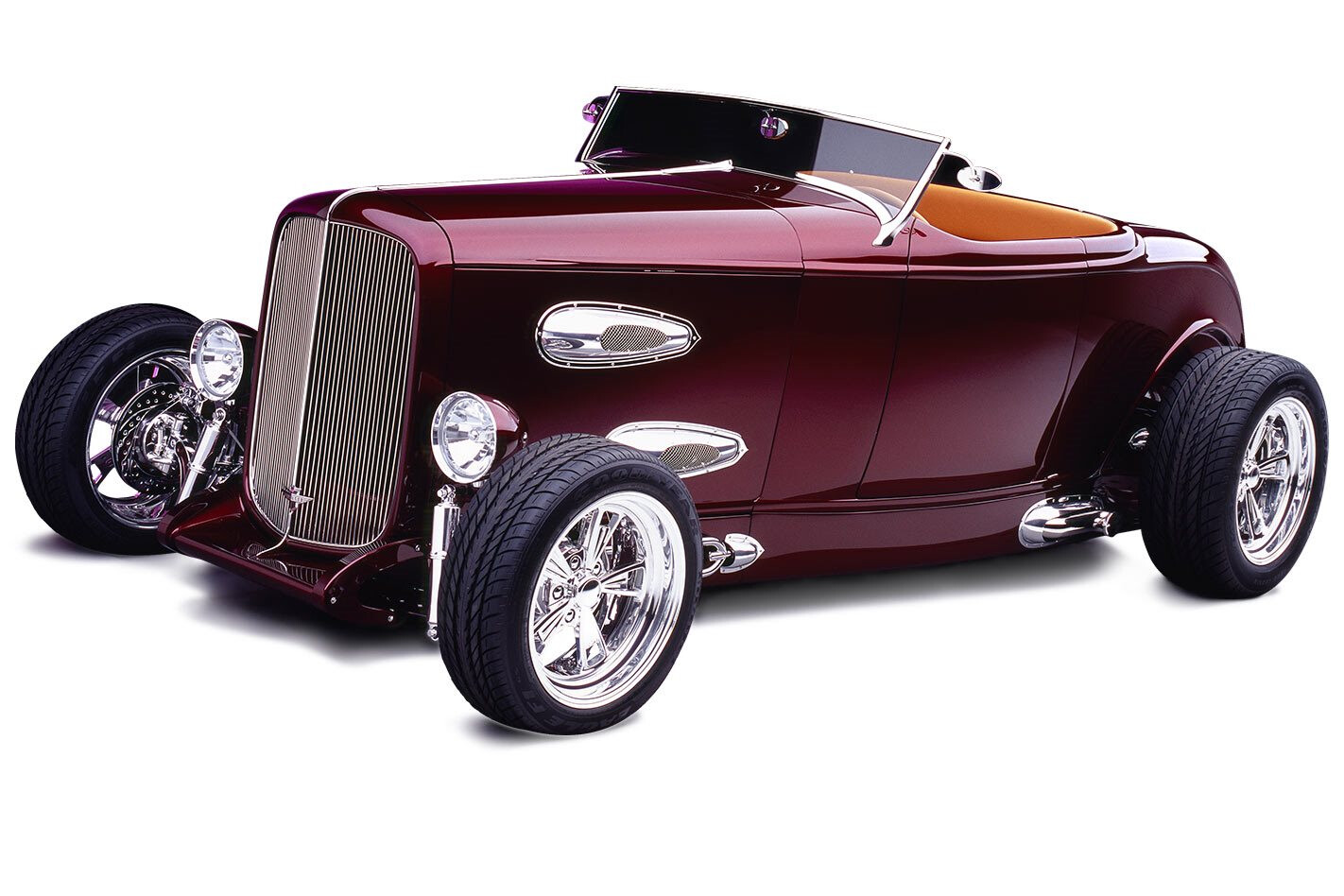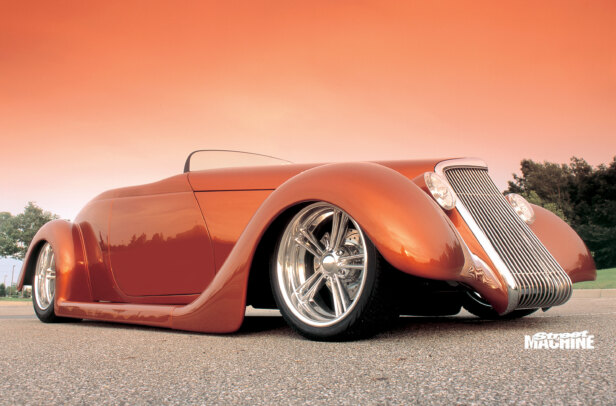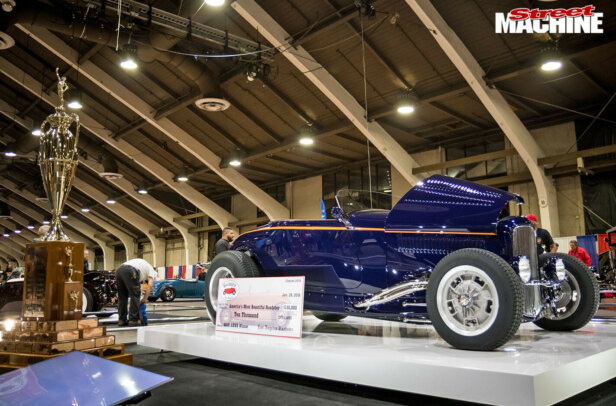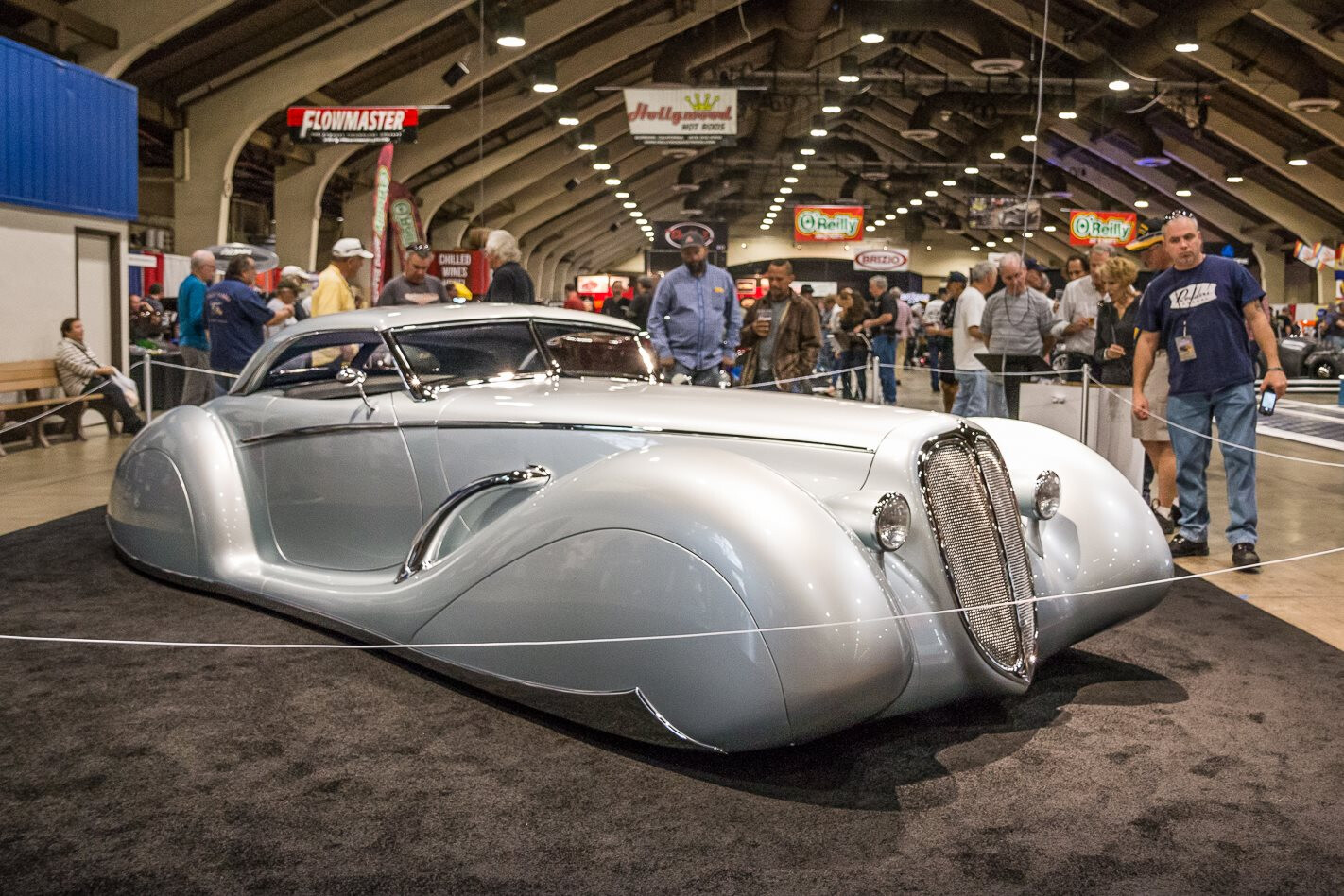This article on Paul’s roadster was originally published in the March 2003 issue of Street Machine magazine
THERE’S an old saying that if it walks like a duck, quacks like a duck and looks like a duck, then it probably is a duck. Therefore to most people only slightly familiar with hot rodding, this gleaming piece of automotive art is quite obviously a ’32 Ford roadster.
It’s got that distinctive grille shell, a piece of design that’s often described as a classic example of Art Deco styling, the unmistakable Deuce rails, and the clean profile that defines a ’32 Ford.
But not all is as it appears. In fact the entire car has been hand-built from the ground up by Steve Moal and his team at Moal Coachbuilders (www.moal.com), wife Theresa and sons Michael and David. The customers were another family team, father and son Paul and Erik Hansen.
Power for Sedeuced is produced by a 383ci Chev small-block. The donk is full of the good gear and topped by a Whipple supercharger and a pair of 750cfm Mighty Demons. The rocker covers were carved from solid billet and mirror finished
When I say hand-built, I really mean it. This hot rod wasn’t just screwed together from a bunch of store-bought parts; this car was carved and shaped by hand from raw steel and alloy.
Instead of hiding the master cylinders, Sedeuced makes a feature of its retro-styled units on the firewall
For instance, the wheels are a one-off custom design by Steve Moal, whittled from solid billet by Li’l John Buttera. Not impressed? John also did the rocker covers that feature the name of the car, Sedeuced, as a logo. Still yawning? Okay, the entire diff pumpkin was CNC-machined by John and if that still isn’t impressing you, he carved the sump from a solid chunk too.
Although there’s a whole heapin’ helpin’ of billet on this car, it’s not obvious as the whole lot has been polished to a mirror finish to remove the freshly milled look so popular in the 80s. Instead, the appearance is of finely cast and finished alloy components and a whole lot better for it.
Even the chassis is not what it seems. It looks for all the world like a set of ’32 rails but the entire chassis is a tubular structure put together by Moal’s. The main chassis tubes are 15/8-inch diameter and they’re tied together with 1¼ and one-inch tubes. In effect, the rails are really just panels to hide the chassis.
The advantage of designing the chassis this way is that it is a lot lighter and was made slightly longer in the wheelbase at 110 inches, four inches longer than a standard ’32 chassis. It also allowed them to dial in 50:50 weight balance front to rear – highly desirable for good handling, but rare in a hot rod.
Rather than use the more common double A-arm type front suspension with four-bar axle location, the Hansens plumped for the traditional-looking dropped and drilled front axle, located with tapered hairpins and suspended on torsion bars instead of the factory style transverse spring. Instead of a Panhard rod, the axle has a built-in side controller linked to a centrally located pivot point
It is also common knowledge that there are probably more ’32 roadsters on the road now than were ever produced by Henry Ford. With the popularity of fibreglass bodies over the past 20 years, as well as the more recent addition of steel reproduction bodies, you would think the easy way out would be to get one of those and modify it to your tastes.
Like I said, that would be the easy way out. You might have noticed the ‘Coachbuilders’ part of the Moal business name. That means these guys aren’t scared to make an entire car body out of nothing but flat sheets of metal and an English wheel. So that’s what they did.
Although the car is most definitely a ’32 roadster, there are many subtle differences. The bonnet has been stretched and the grille widened and shortened. The doors are also two inches longer and the body reveal that runs along the length of the body and normally stops at the bonnet’s edge has been extended ever so slightly, so that it finishes at a point on the side of the grille shell.
Then there’s the rolled rear pan and subtle nerf bar finishing off the back of the car. The whole lot has then been covered in a flawless coat of PPG Sedeuced Red Pearl by renowned painter Darrel Hollenbeck. Tail-lights can make or break a hot rod, so the Moal team made up a custom set similar to the often-used ’39 Ford teardrops. They’ve been slightly frenched and dressed up with a custom-made chrome bezel and are a very classy nod to the classic style of the ’39 but are different enough for people to take notice.
Another name that you often see mentioned in US hot rod stories is that of Sid Chavers. His interiors are some of the most stunning ever to have bums sat on them. Using Danish leather that was custom-dyed a dark tan colour, Sid stitched up a simple yet elegant interior that contrasts beautifully with the deep red of the exterior.
Owner Paul Hansen doesn’t like louvres so the team came up with these wire-screened ‘speed blisters’ as an alternative method of getting heat out of the engine bay. Steve Moal took inspiration from similar outlets used on Duesenbergs, Cords and Bugattis
The cockpit also sports a custom steering wheel following the same Moal-design as the wheels, custom-made pedals, and a stunning gauge panel that houses a set of instruments which were specially tailored by Classic Instruments.
So finally we get to the good bit, the donk! Quite often people build hot rods with the external cues hinting at massive horsepower. They’ve got the huge treads out back, the big exhaust, the low stance, but then make the excuse that “I wanted something reliable” and stuff a bog stocker under the bonnet. Sure enough it’ll be detailed to the hilt and look a million bucks but it’s still a stocker under all that chrome and paint.
Inside is just gorgeous. The trim is Danish leather and the dash, a custom-built unit, is filled with specially made Classic Instruments. The door panels echo the speed blisters and screen theme seen on the outside, just as the custom tiller echoes the road wheels. Check the way the inner door metal work flows into the dashboard. Even the belt buckles are art!
The Hansens are a little different. The original plan was to “build a bad-arse highboy with a big motor” so it’s no surprise that there’s some serious mumbo up front.
Starting off with a 383 stroker, fitted with a SCAT crank, Crower I-beam rods and a Comp cam, the motor gets stuffed full of high-octane thanks to a twin-screw Whipple supercharger and a pair of 750cfm Mighty Demon carbs. Is 700hp bad enough?
All that good mumbo has to go somewhere, so the Hansens chose to send it through a fully polished and detailed Tremec five-speed and then out to that previously mentioned billet pumpkin, which was stuffed with a Currie LSD centre and Strange axles. Stout stuff indeed!
The teardrop theme seen in the tail-lights, mirrors and pedals is repeated in the shifter design (above and below)
After reading all this, you’re probably wondering what the point is – all that time and money on a car that will never see the road. In the US there are a couple of show trophies that are sought-after by every serious car builder. These are The Ridler Award, handed out at the Detroit Autorama to the best car never shown before, and America’s Most Beautiful Roadster (AMBR), the legendary nine-foot trophy awarded at the Grand National Roadster Show (GNRS) in California.
No, Sedeuced didn’t win both but it got very close. After narrowly missing out on the Ridler in 2004, the car went to the Fresno Autorama where it won a swag of trophies.
It was then put away until January this year where it was displayed at the GNRS. And as you may recall from recent issues of Street Machine, the story does have a happy ending. Against some very tough competition, the Hansen’s took home the AMBR.
The plan is to do a few more shows over the next year or so then start driving it – but don’t worry, those chromed brake discs will be swapped for something with a little more bite.
SEDEUCED IN DETAIL:
- Underneath is a Tremec five-speed which harnesses the 700hp blown small-block. This car is a beautiful combination of beauty and brawn
- Like the billet rims? You’ll have a hard time buying a set because they were handmade by US hot rod legend Li’l John Buttera. Compare the styling of the rims to the design of the tiller and you get an idea of just how cohesive and well-planned this car is
- Every panel on this car was hand-formed from steel and aluminium. It looks like a ’32 roadster but has a ton of subtle differences. For example the doors are two inches longer than factory, the bonnet is longer and has radiused corners, and the grille is wider
- An arse with class. Custom tail-lights are similar to ’39 Ford teardrops and have been artfully sunken into the metalwork. The exhaust tips swoop upwards in the style of early Ferraris. Underneath, the diff housing was milled from a solid piece of aluminium
- Local rego rules meant that nerf bars like this were much more common on early Australian hot rods than their American counterparts back in the day so it’s something of a surprise to see them on Sedeuced. We reckon they look fantastic
PAUL AND ERIK HANSEN
1932 FORD
Colour: PPG Sedeuced Red Pearl
ENGINE
Engine: Chev 383ci
Crank: SCAT
Rods: Crower I-beam
Pistons: JE
Cam: Comp
Blower: Whipple
Heads: Brodix Track 2
Carbs: Mighty Demon 750cfm
SHIFT
Box: Tremec five-speed
Clutch: McLeod
Diff: Fabricated housing; Strange axles; Currie LSD
RIDE
Suspension: Custom-made aluminium axle, torsion bars, custom-made billet shocks (f); four bar, torsion bars, custom-made billet shocks (r)
Brakes: Wilwood 11in cross-drilled discs, four-piston Wilwood calipers
Steering: 14:1 NASCAR power-steering box
ROLLING
Rims: Custom-made billets, 16×6 (f), 17x10in (r)
Rubber: Goodyear Eagle F1, 195/50 (f), 295/45 (r)




Comments